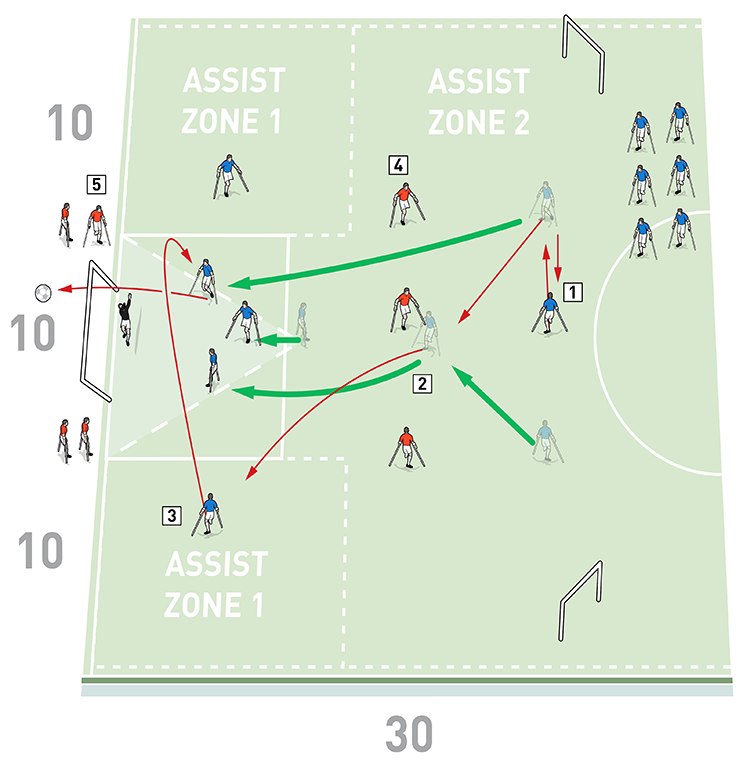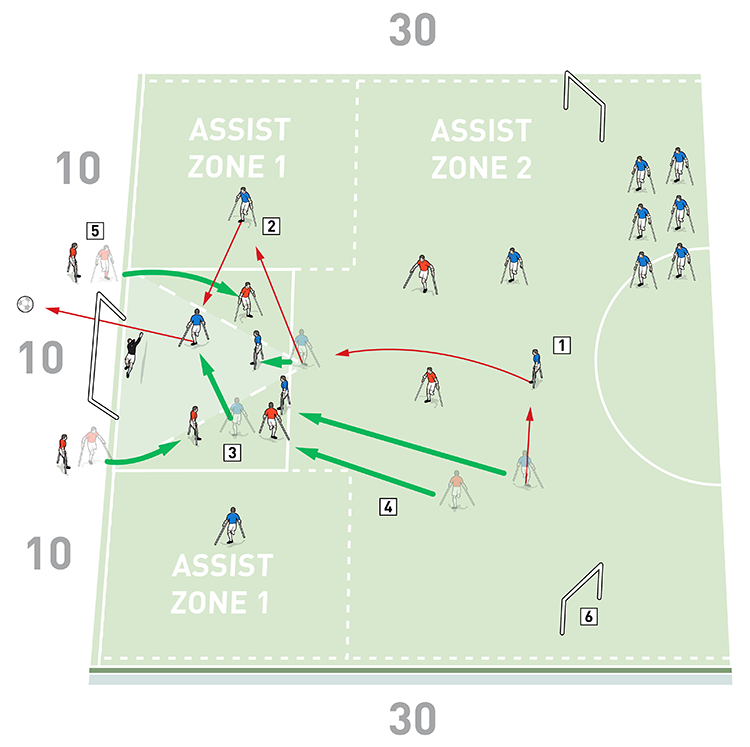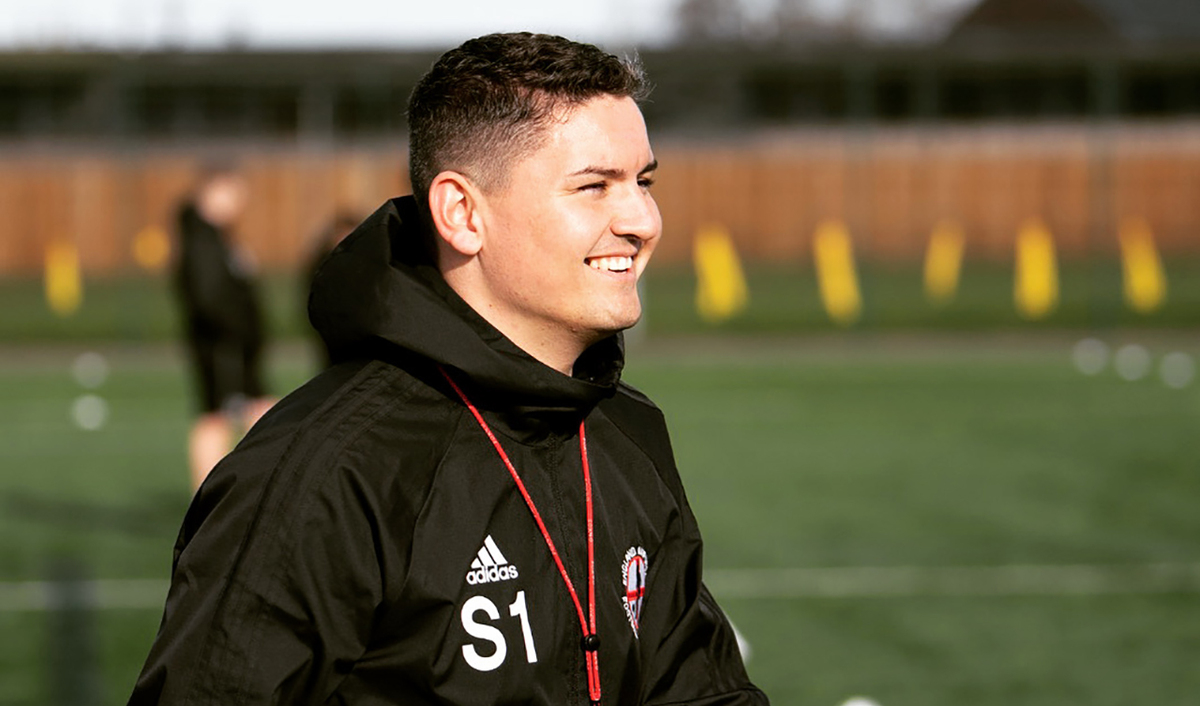You are viewing 1 of your 1 free articles
Finishing in and around the triangle
This session is based on creating opportunities to finish in and around the ‘triangle’, which is the zone that match analysis tells us is where we create the most goal-scoring chances.
| Area | Half your usual pitch |
| Equipment | Balls, bibs, cones, 1 goal, 2 target goals |
| No. of Players | At least 12 players + 1 goalkeeper |
| Session Time |
Attacking the triangle: 15mins, Progression 1: 15mins, Progression 2: 15mins |
This session is based on creating opportunities to finish in and around the ‘triangle’, which is the zone that match analysis tells us is where we create the most goal-scoring chances.
It is designed to replicate game scenarios in order to increase the repetition of scoring opportunities in this specific area, with the eventual aim of increasing productivity. The session also features assist zones in the areas of the pitch where the team sees a high percentage of its goal-scoring moves originating.
It’s an engaging small-sided game designed to provide players with regular scoring chances through a functional practice, which leads into the random practice of the 7v7 game.
It’s also engaging from a goalkeeping and defensive perspective, as it relates to areas of the pitch where most of the opposition’s chances occur, and being able to repeat these situations improves the game understanding, positioning and decision making of the players.
This session was designed with amputee football in mind and it’s based on an historical analysis of the games played by the England Amputee team, so it’s unique to us. We run it on the smaller pitches and with the 9v9 sized goals of the amputee game, but as it’s built around attacking the penalty area it can be run equally well across all codes of football and adapted to whichever pitch/goal size your team plays on. The playing area can also be adapted to suit playing numbers.
ATTACKING THE TRIANGLE
This session allows the players to play in a creative and competitive spirit, with the focus on finishing in and around the ‘triangle’.
We set up a playing area on the final third of the pitch with a goal and a goalkeeper at one end and two target goals at the other end. We mark out a triangle in front of the goal, as shown, with the tip of the triangle one yard outside the penalty area. We also mark 10-yard assist zones on each wing and another assist zone across the width of the playing area starting from the tip of the triangle.
We’re using our full squad of outfield players split into two teams, with at least six attackers and five defenders active for each attack. As it’s a wave attack, any additional players in the squad can wait outside the playing area for their turns to rotate in.
Play starts with a 3v3 in assist zone 2, with the blue attacking team starting with the ball. The blues have to pass the ball under pressure from the three red defenders until they create an opportunity to play the ball to a winger in assist zone 1. The three attackers can now make well-timed runs into and around the triangle, along with their striker who starts at the tip of the triangle, as shown [1]. The attackers must try to score past the goalkeeper from a ball played into the triangle from the winger.
1

2. The three blue attackers can now make well-timed runs into and around the triangle along with their striker, who starts at the tip of the triangle
3. The blue attackers should try to score from a ball played into the triangle from the winger
4. The three red defenders in assist zone 2 stay in their zone. If they win the ball during the 3v3 they should try to clear into one of the target goals
5. Once the attackers get used to the drill, allow two red defenders to enter the penalty area from the side of the goal to help defend the attack
In this particular phase of the practice, the three red defenders in assist zone 2 are not allowed to recover and must stay in their zone. If they win the ball during the 3v3, they should try to pass into one of the target goals at the other end.
When the players get used to attacking unopposed, we can progress this activity by allowing two red defenders to enter the penalty area from either side of the goal to defend against the attack.
PROGRESSION 1
Using the same basic set up as before, play again starts with a 3v3 in assist zone 2. The blue attackers must pass the ball until finding an opening to play out of the zone. This time the attackers can either play the ball to one of the wingers or they can choose to be more direct in their approach and dribble with the ball towards goal before finishing or passing.
In this progression, one of the three red defenders in assist zone 2 can make a recovery run, tracking one of the attackers and helping to defend the penalty area. Two red defenders can also enter play from either side of the goal, as shown [2]. If any of the red defenders wins the ball, they can try to pass into the target goals.
2

2. The blue attackers can now either pass to one of the wingers or they can be more direct and dribble out of the zone before finishing or passing
3. One of the three red defenders in assist zone 2 can now make a recovery run to help defend in the penalty area
4. Two red defenders can enter play from the side of the goal to try to stop the attack
5. If the red defenders win the ball, they try to pass it into one of the target goals
PROGRESSION 2
We use the same basic set up as before but this time we add a second blue striker who starts in or around the triangle. Play again starts with a 3v3 in assist zone 2, with the blues passing the ball until creating the opportunity to launch an attack. They can attack in any way they want – by using the support of the wingers in the wide assist zones or by dribbling or passing directly into the triangle, as shown [3].
3

2. The blues can attack in any way. They can either use the support of the wingers, as here, or they can dribble or pass directly into the triangle
3. The blues now have a second striker who starts in or around the triangle
4. One red defender can make a recovery run into the penalty area
5. Two reds enter play from the side of the goal to help defend
One red defender can make a recovery run into the penalty area to track the attackers and two red defenders can enter the penalty area from either side of the goal to try to stop the attack. If the defenders win the ball they should attempt to clear it into one of the target goals at the other end.
COACHING POINTS
What are the key things to look out for?
We look for good decision making and creativity from the attacking players. They should be able to make well-timed runs and use clinical finishing alongside the use of minimal touches to score.
They should use crisp passing and be able to break lines effectively whilst understanding the importance of angles and support behind and in front of the ball.
What are the typical mistakes players might make and how do I avoid them?
Players will naturally make mistakes in any training session, however some key challenges occur when we deliver this session so we encourage players to remain calm when under pressure and this helps them to make better decisions.
We focus on players making better off-the-ball movements and creating more options for their team-mates when in possession.
It’s important that the size of the area is correct for the number of players in this zone and we can make the area smaller if the attacking players are having too much success.
Another problem is that players can become too predictable and make the same runs each time. To improve the attacking play, we encourage players to vary their movement when attacking space in the triangle.
Players are also encouraged to be creative and to combine well to make chances.
AMPUTEE FOOTBALL
Amputee football is a disabled sport played with seven players on each team: six outfield players and one goalkeeper. It’s a 7v7 game with roll on and roll off substitutes and it’s played on a much smaller pitch (60x40m) than the standard game, using 9v9 sized goals.
Outfield players have lower body amputations or limb deficiencies, and goalkeepers have an upper body amputation or limb deficiency. Outfield players use crutches and play without their prosthesis.
Goalkeepers and outfielders can only use their one dominant leg/arm. Players are not allowed to use their residual limb ‘stump’ to gain an advance as it would be classed as handball. Using a crutch to gain an advantage is also classed as handball.
Goalkeepers must remain in their area at all times, as they would have an advantage on two legs if they were allowed out of the penalty area.
Kick-ins replace throw-ins and there is no offside.
Related Files
Editor's Picks
Deep runs in the final third
Using the goalkeeper in build-up play
Pressing principles
Intensive boxes drill with goals
Penetrating the final third
Creating and finishing
My philosophy
Pressing initiation
Compact team movement
Coaches' Testimonials

Alan Pardew

Arsène Wenger

Brendan Rodgers

Carlos Carvalhal

José Mourinho

Jürgen Klopp

Pep Guardiola

Roy Hodgson

Sir Alex Ferguson

Steven Gerrard
Coaches' Testimonials

Gerald Kearney, Downtown Las Vegas Soccer Club

Paul Butler, Florida, USA

Rick Shields, Springboro, USA

Tony Green, Pierrefonds Titans, Quebec, Canada
Join the world's leading coaches and managers and discover for yourself one of the best kept secrets in coaching. No other training tool on the planet is written or read by the calibre of names you’ll find in Elite Soccer.
In a recent survey 92% of subscribers said Elite Soccer makes them more confident, 89% said it makes them a more effective coach and 91% said it makes them more inspired.
Get Monthly Inspiration
All the latest techniques and approaches
Since 2010 Elite Soccer has given subscribers exclusive insight into the training ground practices of the world’s best coaches. Published in partnership with the League Managers Association we have unparalleled access to the leading lights in the English leagues, as well as a host of international managers.
Elite Soccer exclusively features sessions written by the coaches themselves. There are no observed sessions and no sessions “in the style of”, just first-hand advice delivered direct to you from the coach.









